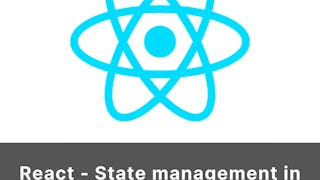React Components are generally implemented using Classes. Although they work well, they have their own set of limitations. The stateful logic provided by the class components lack reusability. To enhance the productivity, codes developers are expected to develop codes with reusability.

Enjoy unlimited growth with a year of Coursera Plus for $199 (regularly $399). Save now.

Building User Interfaces Using Functional React Components
This course is part of Frontend Development using React Specialization

Instructor: NIIT
Included with
What you'll learn
Build React functional components and create reusable and testable stateful logic using React Hooks
Skills you'll gain
Details to know

Add to your LinkedIn profile
2 assignments
See how employees at top companies are mastering in-demand skills

Build your subject-matter expertise
- Learn new concepts from industry experts
- Gain a foundational understanding of a subject or tool
- Develop job-relevant skills with hands-on projects
- Earn a shareable career certificate

There are 2 modules in this course
"A component is the fundamental unit of an SPA which is reusable as it can exist independently. In React, the state of the component is managed within the component. It is therefore recommended to develop a reusable stateful logic that can be used by multiple components. As a React developer, you need to create function components that support Hooks for creating reusable stateful logic .In this learning sprint, you will explore built-in React Hooks and develop custom Hooks with reusable stateful logic. The hands-on assignments included in this learning sprint will enable you to manage state in function components, create side effects like fetching data from the server or handling timer events using built-in React Hooks. You will also learn to develop reusable stateful logic using custom Hooks."
What's included
19 videos2 readings1 assignment2 programming assignments
"Any unit of the code written should be testable. In React, the custom Hooks help to develop reusable stateful logic and hence, as a developer you should write a test code to test the custom Hooks.In this learning sprint, you will explore the functionalities provided by the react-hooks-testing-library for testing custom Hooks. The hands-on assignments included with the sprint will enable you to write test cases to test custom Hooks that manage the state of the component with event triggers, asynchronous server calls and change in props or context values."
What's included
16 videos1 reading1 assignment1 programming assignment
Earn a career certificate
Add this credential to your LinkedIn profile, resume, or CV. Share it on social media and in your performance review.
Explore more from Mobile and Web Development
 Status: Free Trial
Status: Free Trial Status: Free Trial
Status: Free Trial Status: Preview
Status: Preview
Why people choose Coursera for their career





Open new doors with Coursera Plus
Unlimited access to 10,000+ world-class courses, hands-on projects, and job-ready certificate programs - all included in your subscription
Advance your career with an online degree
Earn a degree from world-class universities - 100% online
Join over 3,400 global companies that choose Coursera for Business
Upskill your employees to excel in the digital economy
Frequently asked questions
To access the course materials, assignments and to earn a Certificate, you will need to purchase the Certificate experience when you enroll in a course. You can try a Free Trial instead, or apply for Financial Aid. The course may offer 'Full Course, No Certificate' instead. This option lets you see all course materials, submit required assessments, and get a final grade. This also means that you will not be able to purchase a Certificate experience.
When you enroll in the course, you get access to all of the courses in the Specialization, and you earn a certificate when you complete the work. Your electronic Certificate will be added to your Accomplishments page - from there, you can print your Certificate or add it to your LinkedIn profile.
Yes. In select learning programs, you can apply for financial aid or a scholarship if you can’t afford the enrollment fee. If fin aid or scholarship is available for your learning program selection, you’ll find a link to apply on the description page.
More questions
Financial aid available,


